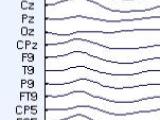Interictal spikes are transient events, characteristic of epilepsy, that occur between seizures. They are generated by the brain without any clinical signs, thus allowing multimodal imaging studies. Scalp EEG recordings have an excellent temporal resolution (~ 1 ms) but its visual interpretation provides only imprecise localization, indicating at best which lobe was involved during the epileptic discharge. EEG source localization methods may help to determine the regions of the brain where the spikes are generated. Moreover, as opposed to other imaging modalities (such as fMRI and PET), EEG or MEG data are the only direct measurements of neuronal activity. Performing an accurate localization of EEG sources of interictal spikes is thus of particular interest to better understand their generation and propagation.
Inferring the source location within the brain from a signal acquired on the scalp, i.e., the EEG inverse problem, is an ill-posed problem since there is an infinite number of source configurations that can produce the exact same potential at the surface of the head. Additional constraints should then be added to obtain a unique solution. Two types of approaches have been proposed(see Baillet et al.IEEE Signal Processing Magazine, pages 14–30.2001 for more details):
- The "equivalent current dipole'' methods assume that the potentials are generated by a few dipolar sources.
- The "distributed source'' methods assume that potentials are generated by a large number of dipolar sources distributed within the brain or on the cortical surface.
- Dipole scanning methods, assessing the presence of an equivalent current dipole on each point of a 3D grid, constitute an intermediate alternative to estimate 3D map of activation indices
In the context of interictal spike localization, equivalent current dipole methods were proved to be useful to localize the "center of mass'' of brain activity (Merlet et al,Clin. Neurophys110(6), 1013–1028,1999). Intracerebral recordings showed that activated brain areas able to generate spikes on the scalp are rarely focal on the cortex, whereas focal deep intra-cerebral sources are almost never detected on surface EEG. A minimum area of cortex needs to be involved in order for the spike to be visible on the scalp, at least several cm2. J. Ebersole (Ebersole,J. of Clin. Neurophys., 14(6), 470–483, 1997)proposed that 6 cm2,seems a good estimate of the minimum area required to see the spike on the scalp. Such a value of 6 cm2should be considered as a low bound. Indeed, widespread spikes involving most of one lobe are not rare. In a recent simulation study (Grova et al.Neuroimage, in press, 2005), we showed that some distributed approaches may be quite accurate to localize interictal spikes with their spatial extent: e.g., maximum smoothness solution (LORETA), maximum entropy of the mean (MEM).
We also developed a method to obtain a probabilistic map of regions likely to be the source of epileptic discharges (Bénar et al, IEEE Trans Biomed Eng. 2005 Mar;52(3):401-13). Because of its probabilistic nature, the method is particularly well suited to comparison with fMRI studies.
For more information, see the lecture of C. Grova at Bayes 05 (Workshop on Bayesian inference and functionnal brain mapping, Centre de Recherche en Mathématiques, Montreal, 2005).



